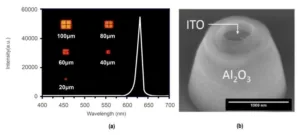Seoul Viosys, the leading global compound semiconductor device provider and a subsidiary of Seoul Semiconductor, announced Seoul Viosys and Santa Barbara’s Solid State Lighting & Energy Electronics Center (SSLEEC) team led by Nobel Prize-winning physics Professor Shuji Nakamura, of University of California, Santa Barbara (UCSB) succeeded in developing blue and green micro LEDs with 1 ?m diameter and addressed issues related to red micro LEDs of less than 70 ?m, which could not be mass-produced due to a decrease in External Quantum Efficiency (EQE).
Seoul Viosys has started mass production and expects it will be a game-changer in the global display industry.
Seoul Viosys and SSLEEC team have overcome the challenges of decrease in External Quantum Efficiency and production yield and Seoul Viosys is successfully mass-producing products (MC04, MC02) to which 70 ?m red micro LED is applied. In addition, it is preparing to release 30 ?m one-pixel Micro LED products in the second half of 2021 and 10 ?m one-pixel Micro LED products in 2022.
Seoul Viosys supported the SSLEEC team for 20 years to develop micro LEDs with a diameter of 1 ?m and made it possible to produce ultra-small micro LED solutions and improve the brightness by increasing the External Quantum Efficiency of red Micro LEDs by 150%, which had been limited to apply because the smaller the size, the lower the light-emitting efficiency. (Thesis Name: Optics Express 5787, Vol. 28, No. 4 (2020) / Appl. Phys. Lett. 116, 071102 (2020))
Accordingly, Seoul Viosys is expecting a rapid commercialization of all display applications such as smartphones, ARs and VRs through improved micro LED technology.
“According to our principle to supply new products first to the companies that respect intellectual property rights, we will first supply the new ultra-small size 10 ?m and 30 ?m one-pixel Micro LEDs to the customers who have purchased our products (MC04, MC02, Wicop MINI, etc.) and are using them,” said an official of Seoul Viosys.
Seoul Viosys regularly presents the results of its joint research with Professor Shuji Nakamura of UCSB at new technology seminars for researchers of Seoul Semiconductor and Seoul Viosys. Micro LED online seminar video held on July 2 is now available on Seoul Semiconductor’s YouTube channel.
*External Quantum Efficiency (EQE): The ratio of the number of photons emitted by the LED divided by the number of injected electrical charges
Video 1) Seoul Viosys’ Micro LED Online Technology Seminar Video
Only part of the seminar has been excerpted and disclosed here due to time and security concerns. If necessary, please contact the sales department.
Video 2) Lecture of Professor Shuji Nakamura at UCSB
Reference: TrendForce, a Taiwanese market research institute, predicted in a recent report that the annual sales of Micro LED chips for TVs will increase to an annual average of 250% from 2021 to 2025. It expected that the size of the market, which was only USD 23 million in 2021, will increase 150 times in just five years.
About Seoul Viosys
Seoul Viosys is a full-line solution provider for UV LED, VCSEL (Vertical Cavity Surface Emitting Laser), the next-generation light source for 3D sensor and laser, and a single-pixel RGB “Micro Clean Pixel” for displays. Established in 2002 as a subsidiary of Seoul Semiconductor, it captured the No. 1 market share in the UV LED industry (LEDinside, 2020). Seoul Viosys has an extensive UV LED portfolio with all wavelengths range (200nm to 1600nm) including ultraviolet rays (UV), visible rays and infrared rays. It holds more than 4,000 patents related to UV LED technology. Violeds, its flagship UV LED technology, provides a wide range of industries with optimal solutions for strong sterilization and disinfection (UVC), skin regeneration (UVB), water/air purification and effective cultivation for horticulture. In 2018, Seoul Viosys acquired RayCan, a leading optoelectronic specialist, to add the advanced VCSEL technology which supports smartphone facial recognition and autonomous driving, and has started its mass production. In January 2020, it introduced a disruptive “Micro Clean Pixel” that has the potential to be a game-changer in the display market.
(BR)

